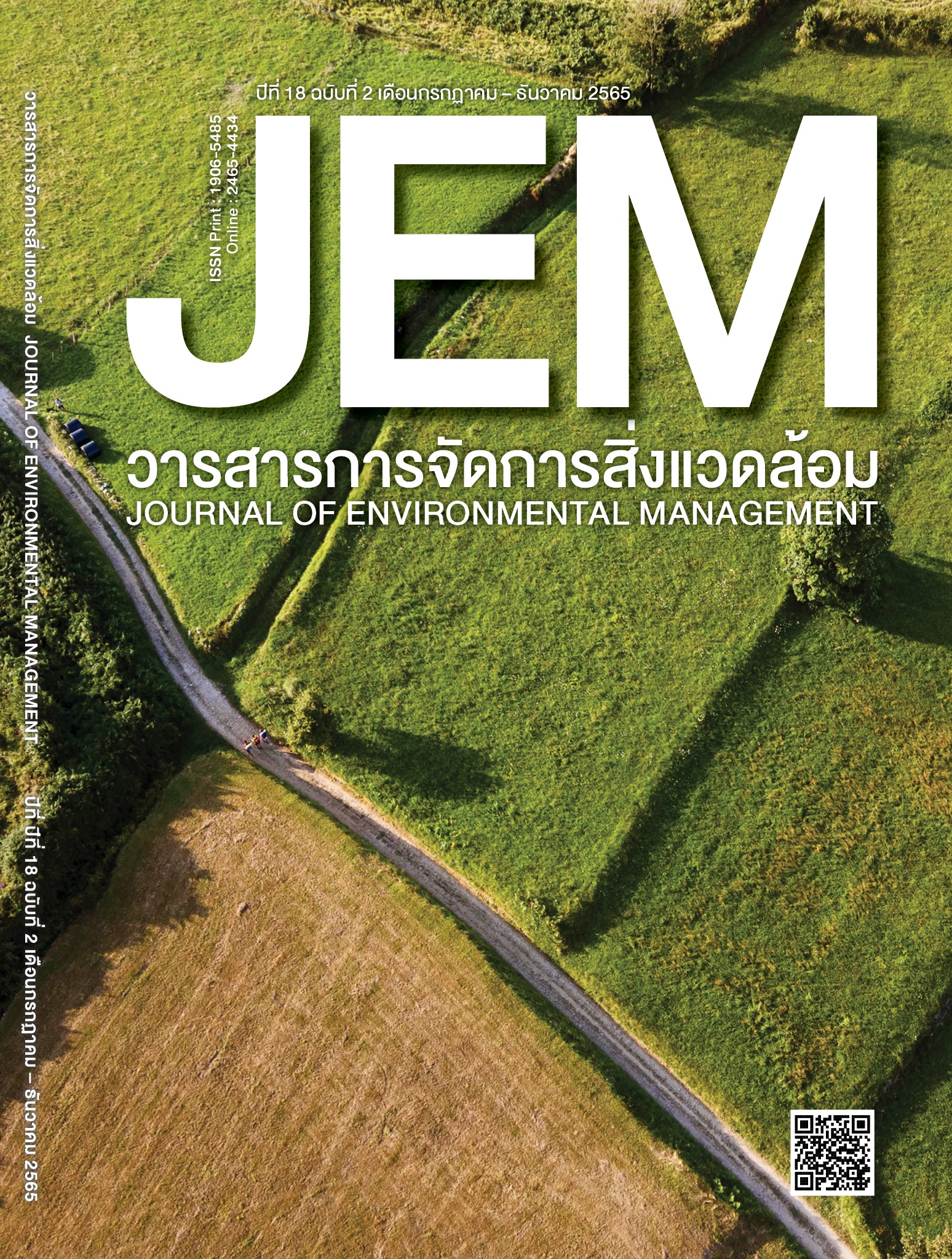การปรับตัวของเกษตรกรอันเนื่องมาจากการเปลี่ยนแปลงสภาพภูมิอากาศที่มีต่อ ระบบนิเวศเกษตรบริเวณลุ่มน้ำแม่ริม จังหวัดเชียงใหม่
DOI:
https://doi.org/10.14456/jem.2022.13คำสำคัญ:
การปรับตัว, การเปลี่ยนแปลงสภาพภูมิอากาศ, ระบบนิเวศเกษตร, เกษตรกรรม, ลุ่มน้ำแม่ริมบทคัดย่อ
บทความวิจัยนี้มีวัตถุประสงค์เพื่อ 1) ศึกษาบริบททางภูมิศาสตร์ ภูมิเศรษฐสังคม และระบบนิเวศเกษตรของลุ่มน้ำแม่ริม 2) วิเคราะห์การเปลี่ยนแปลงสภาพภูมิอากาศของลุ่มน้ำแม่ริมในช่วงระยะ 20 ปี (พ.ศ. 2544 - 2563) และ 3) ศึกษาทางเลือกของการตัดสินใจในด้านการปรับตัวของเกษตรกรต่อการเปลี่ยนแปลงสภาพภูมิอากาศในลุ่มน้ำแม่ริมเมื่อต้องเผชิญกับสถานการณ์ปัญหาภัยแล้งและปัญหาอุทกภัยในระยะยาว ผลการวิจัยแสดงให้เห็นว่า ลุ่มน้ำแม่ริมประกอบไปด้วยระบบนิเวศเกษตร 3 เขต ได้แก่ เขตระบบนิเวศเกษตรที่ลุ่ม เขตระบบนิเวศเกษตรที่ดอน และเขตระบบนิเวศเกษตรที่สูง ซึ่งระบบนิเวศเกษตรทั้งสามเขตนี้ตกอยู่ภายใต้สถานการณ์การเปลี่ยนแปลงสภาพภูมิอากาศในช่วงระหว่างปี พ.ศ. 2544 - 2563 โดยผลการวิเคราะห์ทางสถิติแสดงให้เห็นถึงอุณหภูมิเฉลี่ยรายปีที่มีแนวโน้มสูงขึ้นและปริมาณฝนเฉลี่ยรายปีที่มีแนวโน้มลดลงซึ่งอาจส่งผลกระทบโดยตรงต่อพื้นที่เพาะปลูกของเกษตรกรในอนาคต ดังนั้น เกษตรกรในลุ่มน้ำแม่ริมจึงตัดสินใจเลือกการปรับตัวด้วยการหาอาชีพเสริมทำเป็นทางเลือกอันดับแรกเหมือนกันซึ่งเป็นการปรับตัวเชิงรับ ทั้งนี้ หากนำผลการวิจัยไปปฏิบัติจริงอย่างต่อเนื่อง ร่วมกับการแสวงหาแนวทางการจัดการระบบนิเวศเกษตรร่วมกัน จะเป็นแนวทางการปรับตัวเชิงรุกที่มีประสิทธิภาพเพื่อป้องกันผลกระทบจากการเปลี่ยนแปลงสภาพภูมิอากาศในอนาคตระยะยาว
เอกสารอ้างอิง
Anderson, R., Bayer, P. E., & Edwards, D. (2020). Climate change and the need for agricultural adaptation. Current opinion in plant biology, 56, 197-202.
Dutra, E., Muñoz‐Sabater, J., Boussetta, S., Komori, T., Hirahara, S., & Balsamo, G. (2020). Environmental lapse rate for high‐resolution land surface downscaling: An application to ERA5. Earth and Space Science, 7(5), 1-16.
Fedele, G., Donatti, C. I., Harvey, C. A., Hannah, L., & Hole, D. G. (2019). Transformative adaptation to climate change for sustainable social-ecological systems. Environmental Science & Policy, 101, 116-125.
Getsuwan, R. (2012). Weaknesses of studies on people’s participation in public policymaking in Thailand. Thai Journal of Public Administration, 10(2), 99-99.
Intergovernmental Panel on Climate Change. (2013). Summary for Policymakers. In Stocker, T.F., Qin, D., Plattner, G.-K., Tignor, M., Allen, S.K., Boschung, J., Nauels, A., Xia, Y., Bex, V. and Midgley, P.M. [eds.].
Climate Change 2013: The Physical Science Basis. Contribution of Working Group I to the Fifth Assessment Report of the Intergovernmental Panel on Climate Change. Cambridge; New York: Cambridge University Press.
Ketkaew, T & Tungnitiboon, E. (2018). Assessment Vulnerability of Area by Geographic Information system and Adaption to Climate Change in Ammarit Sub-district, Phak Hai District, Phra Nakhon Si Ayutthaya Province [In Thai]. Bangkok: Dhonburi Rajabhat University.
Matichon Weekly. (2016). Retracing The Great Flood 2011 and The Current Water Management: Progression, Regression or In the Same Position [In Thai]. Retrieved July, 1, 2016, from: http://www.matichonweekly.com/column/article_10569 .
Office of Natural Resources and Environmental Policy and Planning. (2012). Risk Analysis and Assessment Manual of Spatial Vulnerability at the Local Level and Thailand’s Adaptation to Climate Change: Appropriate measures to reduce effects of climate change [In Thai]. Bangkok: Office of Natural Resources and Environmental Policy and Planning Ministry of Natural Resources and Environment.
Office of Natural Resources and Environmental Policy and Planning. (2018). Thailand National’s Adaptation Plan [In Thai]. Bangkok: Ministry of Natural Resources and Environment.
Post Today. (2015). El Nino: Severe Drought and Asian Economic Drop [In Thai]. Retrieved June 18, 2015 from: http://www.posttoday.com/politic/report/389138.
Rosenzweig, C., Mutter, C. Z., & Contreras, E. M. (2021). Handbook Of Climate Change and Agroecosystems-Climate Change and Farming System Planning in Africa and South Asia: AgMIP Stakeholder-driven Research [In 2 Parts] [Vol. 5]. World Scientific.
Saengavut, V., Jirasatthumb, N., Bumrungkit, S., & Krueawamgmol, P. (2019). Vulnerability and Climate Change Adaptation of Smallholding Farmers in Khon Kaen Province [In Thai]. Economics and Public Policy, 10(20), 20 – 37.
Schipper, E. L. F. (2020). Maladaptation: When adaptation to climate change goes very wrong. One Earth, 3(4), 409-414.
Singsin, P., Sirisunyaluk, R., Limnirunkul, B,. & Suriyong, S. (2019). Rice Growers’ Adaptation to Climate Change in Doi Saket District, Chiang Mai Province [In Thai]. Journal of Agriculture, 35(1), 125-136.
Sinnarong, N., Phongaranyapart, K., Memana, B., Amnaj, P., & Thanukeaw, S. (2016). The Adaptation of Farmer for Model Community Development into Climate Change Context of Rice Seed Production Farmer Group [In Thai]. Journal of Community Development Research (Humanities and Social Sciences), 9(3), 114-126.
Sirilakeanun, J., & Srang-iam, W. (2019). Exploring Farmers' Cognition and Adaptation to Climate Variability [In Thai]. Journal of Behavioral Science for Development, 11(2), 151-170.
Sirisatidkt, Pl., Sirisatidkid, C, S., & Sitthichok, T. (2020). The Study of Farmer’s Gathering in Phatthalung to Develop Model for Adaptation among Effect of Rubber and Palm Oil Plantations [In Thai]. School of Administrative Studies Academic Journal, 3(4), 50-65.
Suta, R., Khempet, S., & Jongkaewwattana, S. (2014). Perception and Adaptation of Upland Farmer’s Production System to Climate Variability [In Thai]. Khon Kaen Agriculture Journal, 42(2), 190-197.
Thampanishvong K., Anuchitworawong C., Wijukprasert P., Saramul S., Keawmesri T., & Leangcharoen, P. (2015). Adaptation of Rice Farmers in Ranod to Climate Change [In Thai]. Bangkok: Thailand Development Research Institute.
Thipsuwan, C. (2015). Factors of Integrated Water Resource Management of Mae Rim Sub Watershed, Chiang Mai Province [In Thai]. Social Academic, 8(1), 1-10.
Thongmeethip, K. (2021). Agricultural Development in Thailand in Terms of Community Development in Terms of Community Development and Quality of Life and Quality of Life [In Thai]. Journal of Development Studies, 4(1), 132-162.
Wang, L., Sousa, W.P., & Gong, P. (2004). Integration of object-based and pixel-based classification for mapping mangroves with IKONOS imagery. International Journal of Remote Sensing, 25(24): 5655-5668.
World Meteorological Organization. (2020). WMO Confirms 2019 as Second Hottest Year on Record [online]. Retrieved June 20, 2019, from: https://public.wmo.int/en/media/press-release/wmo-confirms-2019-second-hottest-year-record.
Xu, W., & Mage, J.A. (2001). A review of concepts and criteria for assessing agroecosystem health including a preliminary case study of Ontario. Agriculture, Ecosystem and Environment, 83, 215-233.
Yamane, T. (1973). Statistics: An introduction analysis. New York: Harper & Row.
Zobeidi, T., Yaghoubi, J., & Yazdanpanah, M. (2022). Farmers’ incremental adaptation to water scarcity: An application of the model of private proactive adaptation to climate change (MPPACC). Agricultural Water Management, 264, 107528.



